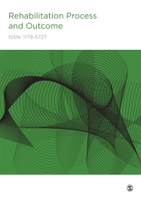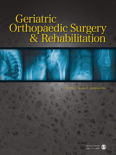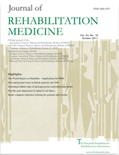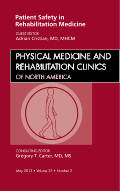
Rehabilitation Process and Outcome
Scope & Guideline
Enhancing patient care through collaborative knowledge.
Introduction
Aims and Scopes
- Multidisciplinary Approaches to Rehabilitation:
The journal encourages research that integrates various disciplines such as medicine, psychology, and occupational therapy to enhance rehabilitation outcomes. - Innovative Technologies in Rehabilitation:
There is a consistent emphasis on the incorporation of technology, such as tele-rehabilitation and computer vision, which aims to improve the delivery and efficacy of rehabilitation services. - Patient-Centered Care and Perspectives:
Research that explores the views and experiences of patients and caregivers in rehabilitation processes is a core area, highlighting the importance of user feedback in shaping rehabilitation practices. - Evaluation of Rehabilitation Models and Frameworks:
The journal publishes studies that assess and validate rehabilitation models, ensuring they align with established health classifications and frameworks, such as the WHO's International Classification of Function. - Feasibility and Acceptability Studies:
A strong focus is placed on studies that evaluate the feasibility, safety, and acceptability of new interventions and platforms in rehabilitation settings.
Trending and Emerging
- Tele-Rehabilitation and Remote Services:
There is a growing trend towards exploring the feasibility and effectiveness of tele-rehabilitation services, particularly in response to the needs of patients with spinal cord injuries and brain injuries. - Use of Digital Health Tools:
The rise of digital health tools, including eHealth platforms and mobile applications, is increasingly being investigated for their potential to enhance pre-surgical education and rehabilitation outcomes. - Integration of Biomarkers and Physical Functioning:
Research exploring the relationship between biomarkers and physical functioning is emerging, particularly in the context of cancer rehabilitation, which may lead to more personalized rehabilitation strategies. - Human Motion Analysis Technologies:
The application of advanced technologies, such as computer vision for motion analysis, is becoming a key focus area, promising to enhance assessment techniques in rehabilitation. - Qualitative Research on Patient Experiences:
There is an increasing emphasis on qualitative studies that capture patient and caregiver perspectives, ensuring that rehabilitation practices are aligned with the needs and preferences of those directly affected.
Declining or Waning
- Traditional Rehabilitation Practices:
There is a noticeable decrease in research focusing on traditional rehabilitation methods, possibly due to the shift towards more innovative and technology-driven approaches. - Generalized Rehabilitation Models:
Research centered on broad or generalized models of rehabilitation has waned, as there is now a preference for more specific, condition-focused studies that address unique patient needs. - In-person Rehabilitation Studies:
The emphasis on in-person rehabilitation studies has diminished, likely as a result of the increasing acceptance and implementation of tele-rehabilitation methodologies.
Similar Journals

Rehabilitation Research and Practice
Advancing Rehabilitation Through Innovative Research.Rehabilitation Research and Practice is a distinguished open-access journal published by HINDAWI LTD, dedicated to advancing knowledge in the fields of rehabilitation, physical therapy, and sports therapy. With its ISSN 2090-2867 and E-ISSN 2090-2875, the journal has been a pivotal resource for researchers and practitioners since its inception in 2010. Based in Egypt and reaching an international audience, the journal encapsulates cutting-edge research and evidence-based practices that significantly contribute to patient care and rehabilitation strategies. Notably, it holds a reputable position in the Scopus rankings—42nd out of 161 in Medicine Rehabilitation and 74th out of 247 in Health Professions. The journal enjoys a Q2 status in the 2023 category quartiles, reflecting its influence and quality within the academic community. The journal's commitment to an open-access format not only enhances its visibility and accessibility but also fosters collaboration among professionals, making it an indispensable resource for anyone engaged in rehabilitation research and practice.

Geriatric Orthopaedic Surgery & Rehabilitation
Fostering collaboration to improve lives of older patients.Geriatric Orthopaedic Surgery & Rehabilitation is a vital open-access journal published by SAGE Publications Inc. since 2010, dedicated to advancing the field of geriatric healthcare through a rigorous focus on orthopaedic surgery and rehabilitation. With a commitment to disseminate high-quality research, it holds impressive rankings in various categories, reflected in its Q2 quartile status in Orthopedics and Sports Medicine, Rehabilitation, and Surgery, alongside a Q3 ranking in Geriatrics and Gerontology as of 2023. This journal plays a crucial role in bridging the gap between clinical practice and research, providing a platform for professionals and researchers to exchange innovative ideas and findings that enhance patient outcomes in this specialized area. The journal's scope encompasses a broad range of topics pertinent to the geriatric population, ensuring that the latest developments and therapeutic strategies are accessible to practitioners and scholars alike. With its commitment to advancing knowledge and practice, Geriatric Orthopaedic Surgery & Rehabilitation serves as an essential resource for those dedicated to improving the health and mobility of older adults.

HSS Journal
Advancing orthopedic excellence through rigorous research.The HSS Journal, published by SAGE Publications Inc, is a prominent scholarly journal dedicated to advancing knowledge in the fields of Orthopedics, Sports Medicine, and Surgery. With a robust ISSN of 1556-3316 and E-ISSN 1556-3324, this journal has been rigorously contributing to the medical community since its inception in 2006, with a convergence set to last through 2024. The journal boasts a commendable impact factor, positioning it in the Q2 category for both Orthopedics and Sports Medicine, as well as Surgery, highlighting its significance and credibility within these domains. The HSS Journal's Scopus rankings further underscore its scholarly impact, placing it in the 75th percentile for Surgery and 67th percentile for Orthopedics and Sports Medicine. Dedicated to providing high-quality, peer-reviewed articles, the journal serves as an essential resource for researchers, clinicians, and students eager to stay abreast of the latest advancements and best practices in surgical care and orthopedics.

JOURNAL OF REHABILITATION MEDICINE
Bridging Research and Practice for Better Patient OutcomesJOURNAL OF REHABILITATION MEDICINE, published by the FOUNDATION REHABILITATION INFORMATION in Sweden, stands as a leading platform for the dissemination of groundbreaking research in the field of rehabilitation. With an impact factor that places it in the Q1 category for Physical Therapy and Rehabilitation and a noteworthy Q2 ranking in Sports Science and Medicine (miscellaneous), this journal serves as an essential resource for researchers, clinicians, and students dedicated to improving patient care and rehabilitation outcomes. As an Open Access publication since 2001, it ensures that knowledge is widely accessible, promoting collaborative efforts across the global rehabilitation community. Aiming to bridge the gap between research and clinical practice, the journal covers a comprehensive range of topics, providing a vital forum for innovative studies that advance the understanding and effectiveness of rehabilitation therapies. As it approaches its convergence into 2024, the JOURNAL OF REHABILITATION MEDICINE continues to be a cornerstone for all those committed to advancing rehabilitation sciences.

Archives of Rehabilitation Research and Clinical Translation
Driving Change in Rehabilitation with Cutting-Edge ResearchArchives of Rehabilitation Research and Clinical Translation, published by ELSEVIER, is a leading open access journal dedicated to advancing the field of rehabilitation research and clinical practice. Since its inception in 2019, the journal has made significant contributions to the understanding of rehabilitation methodologies and interventions, showcasing innovative research that bridges the gap between clinical practices and rehabilitation science. With an impressive impact factor and essential Scopus rankings—#56 in Rehabilitation Medicine and #94 in Physical Therapy—this journal is highly regarded in its fields and reaches a diverse international audience. The open access format promotes widespread dissemination of scholarly work, ensuring that vital research findings are accessible to all practitioners, researchers, and students worldwide. As a trusted platform for high-quality research, the journal encourages rigorous scientific exploration and fosters collaboration among professionals striving to improve the quality of rehabilitation services.

Physiotherapy Practice and Research
Connecting research and practice for better health outcomes.Physiotherapy Practice and Research is a pivotal journal published by IOS PRESS that focuses on the dynamic field of rehabilitation and physiotherapy. Since its inception in 2009, this journal has provided a scholarly platform for researchers, clinicians, and students to disseminate innovative findings and practical applications in occupational therapy, sports medicine, and rehabilitation sciences. Although the journal currently holds Q3 and Q4 rankings in several categories, including occupational therapy and physical therapy, its impact in fostering research collaboration and informing practice is becoming increasingly important in advancing patient care and rehabilitation outcomes. With an ongoing commitment to open-access principles, the journal welcomes original research and review articles that address contemporary challenges and emerging practices within the field. As the journal continues to evolve, it aims to engage more deeply with the global research community, unlocking vital discussions that shape the future of physiotherapy.

PHYSIKALISCHE MEDIZIN REHABILITATIONSMEDIZIN KURORTMEDIZIN
Advancing Rehabilitation: Where Innovation Meets PracticePHYSIKALISCHE MEDIZIN REHABILITATIONSMEDIZIN KURORTMEDIZIN, published by GEORG THIEME VERLAG KG, is a prominent journal dedicated to the fields of physical medicine, rehabilitation, and resort medicine. With its ISSN of 0940-6689 and E-ISSN 1439-085X, this journal has been at the forefront of disseminating essential research and innovative practices since its inception. Operating from Germany, it offers a crucial platform for professionals, researchers, and students engaged in exploring the latest advancements in rehabilitation methodologies and therapeutic practices. Although it currently holds a Q4 ranking in several categories including Physical Therapy and Rehabilitation, the journal is committed to enhancing its impact and visibility within the academic community. The journal publishes research, reviews, and clinical studies aimed at improving patient outcomes and advancing the science of rehabilitation. Subscribers can expect high-quality content that addresses both theoretical and practical aspects of rehabilitation medicine, ultimately contributing significantly to ongoing discussions and developments in the field.

Physical Medicine and Rehabilitation Clinics of North America
Connecting professionals with the latest in rehabilitation science.Physical Medicine and Rehabilitation Clinics of North America is a leading journal published by W B Saunders Co-Elsevier Inc., focusing on the multifaceted disciplines of physical medicine, rehabilitation, and related health professions. With an impressive impact factor reflecting its significant contribution to the field, this journal ranks in the Q2 quartile for both Physical Therapy and Rehabilitation categories. The journal, available in both print (ISSN: 1047-9651) and online (E-ISSN: 1558-1381), provides critical insights, clinical updates, and comprehensive reviews that are essential for researchers, practitioners, and students alike. Covering a wide spectrum of topics from innovative rehabilitation techniques to emerging trends in sports medicine, it aims to disseminate knowledge that enhances patient care and drives advancements in rehabilitation practices. With a publication history spanning from 1995 to 2024, Physical Medicine and Rehabilitation Clinics is an essential resource for those dedicated to improving functional outcomes and the quality of life for patients worldwide.

REHABILITATION
Transforming Rehabilitation Through Innovative ResearchREHABILITATION is a leading peer-reviewed journal published by GEORG THIEME VERLAG KG, dedicated to advancing the field of rehabilitation. With a rich history dating back to 1972 and converging into 2024, this journal plays a pivotal role in disseminating high-quality research that addresses critical challenges in rehabilitation science and practice. Although it is currently categorized in the third quartile (Q3) of the Rehabilitation category for 2023, its contribution is essential for professionals and researchers striving to improve therapeutic strategies and patient outcomes. The journal strives to publish original research, comprehensive reviews, and insightful commentaries that challenge current paradigms and inspire further inquiry in the field. To remain competitive and relevant, REHABILITATION continually seeks to elevate its global impact, making it a valuable resource for academics and practitioners alike, despite its current Scopus rank of #110 out of 161 in the Medicine _ Rehabilitation category. Located in Stuttgart, Germany, it serves as a crucial platform where innovative ideas and methodologies are shared amongst the international rehabilitation community.

Romanian Journal of Oral Rehabilitation
Elevating Standards in Oral Rehabilitation ResearchThe Romanian Journal of Oral Rehabilitation is a premier Open Access journal dedicated to advancing the field of oral rehabilitation through high-quality, peer-reviewed research. Published by the Romanian Society of Oral Rehabilitation Association since 2009, this journal provides a vital platform for the dissemination of innovative findings, clinical practices, and case studies that shape the landscape of oral health care. With a commitment to accessibility, it ensures that researchers, professionals, and students can readily access the latest advancements in the discipline. The journal's impact is underscored by its growing reputation within the scientific community, fostering collaboration and knowledge sharing among experts in the field. Whether you are engaged in clinical practice, research, or education in oral rehabilitation, the Romanian Journal of Oral Rehabilitation serves as an essential resource for throughout your scholarly pursuits.